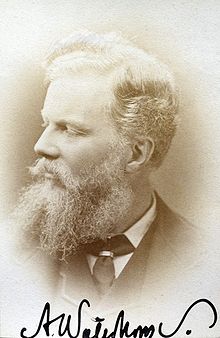Alfred Waterhouse
| Alfred Waterhouse | |
|---|---|

Alfred Waterhouse
|
|
| Born |
19 July 1830 Aigburth, Liverpool, Lancashire, England |
| Died | 22 August 1905 (aged 75) Yattendon, Berkshire, England |
| Occupation | Architect |
| Buildings |
Natural History Museum, London Manchester Town Hall Manchester Assize Courts Manchester Museum Clock Tower at Rochdale Town Hall |
Alfred Waterhouse RA (19 July 1830 – 22 August 1905) was an English architect, particularly associated with the Victorian Gothic Revival architecture. He is perhaps best known for his design for Manchester Town Hall and the Natural History Museum in London, although he also built a wide variety of other buildings throughout the country. Financially speaking, Waterhouse was probably the most successful of all Victorian architects. Though expert within Neo-Gothic, Renaissance revival and Romanesque revival styles, Waterhouse never limited himself to a single architectural style.
Waterhouse was born on 19 July 1830 in Aigburth, Liverpool, Lancashire, the son of wealthy mill-owning Quaker parents. His brothers were accountant Edwin Waterhouse, co-founder of the Price Waterhouse partnership that now forms part of PriceWaterhouseCoopers and solicitor Theodore Waterhouse, who founded the law firm Waterhouse & Co, now part of Field Fisher Waterhouse LLP in the City of London.
Alfred Waterhouse was educated at the Quaker Grove House School in Tottenham. He studied architecture under Richard Lane in Manchester, and spent much of his youth travelling in Europe and studying in France, Italy and Germany. On his return to Britain, Alfred set up his own architectural practice in Manchester.
...
Wikipedia
